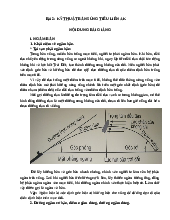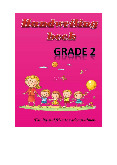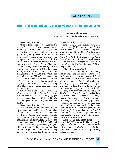



Preview text:
Tr°¡ng Thị Ánh Nguyệt - 22115188 PPHĐH 3 1194 3 Nhóm 2
PHONG CÁCH HỌC TẬP CÁ NHÂN
I. Chỉ sá test của Richard Felder và Linda Silverman 1. Biểu đồ kÁt quÁ: 2. Phân tích kÁt quÁ:
Dựa vào kÁt quÁ mô hình Chỉ sá phong cách học tập do Richard Felder
và Linda Silverman phát triển, em đã xác định đ°ợc phong cách học tập cá nhân nh° sau:
- Em là ng°ời khá cân bằng giữa việc học trực tiÁp (Active) và gián tiÁp
(Reflective). Tuy nhiên, em có thiên h°ớng về học chủ động nhiều
h¡n. Hay nói cách khác, em chủ động xử lý thông tin bằng cách nói và thử nó.
- Em tiÁp nhận thông tin một cách cụ thể, quen thuôc và thiÁt thực. Em
thích các sá liệu, quy trình và ứng dụng kiÁn thức vào thực tiễn.
- Em yêu thích việc học qua hình Ánh, đồ thị, s¡ đồ, biểu đồ,…
- Em tổ chức thông tin một cách toàn diện, ngẫu nhiên. Những thông tin
th°ờng đ°ợc tổ chức một cách vô thức nên em th°ờng s¿ có những
sáng t¿o bất chợt trong mỗi công việc. Tuy nhiên, em vẫn sắp xÁp
thông tin theo hệ tháng, tuần tự nhất định.
II. ¯u 3 Nh°ợc điểm của bÁn thân ¯u điểm Nh°ợc điểm
- Chủ động tiÁp nhận, trÁi nghiệm
- Gặp khó khăn trong việc tiÁp
những thông tin, thử thách mới,
nhận bài giÁng với phần lớn là lý
hay chủ động trong làm việc
thuyÁt trừu t°ợng và việc ghi
nhóm, tham gia các cuộc họp,…
nhớ, áp dụng nó vào thực tiễn.
- KhÁ năng học tập bằng sự t°ởng
- Ch°a nghiên cứu sâu vào những
t°ợng, hình Ánh, đồ ho¿. chi tiÁt. - KhÁ năng nhìn đ°ợc
tổng thể= của vấn đề, đọc l°ớt,… GiÁi pháp:
- Cá gắng tìm các kÁt nái về lý thuyÁt đã học, thÁo luận, diễn giÁi với
giÁng viên về các lý thuyÁt.
- Cẩn thận không bß lỡ các chi tiÁt khi đánh giá công việc, dnahf nhiều
thời gian để đắm mình vào một chủ đề.
- Luyện tóm tắt, dàn ý tài liệu bằng văn bÁn. III. BÀN GàC TIÀNG ANH
ACTIVE AND REFLECTIVE LEARNERS •
Active learners tend to retain and understand information best by doing
something active with it4discussing or applying it or explaining it to others.
Reflective learners prefer to think about it quietly first. • •
Active learners tend to like group work.
SENSING AND INTUITIVE LEARNERS •
Sensing learners tend to like learning facts. •
Sensors often like solving problems by well-established methods and dislike
complications and surprises. Sensors are more likely than intuitors to resent
being tested on material that has not been explicitly covered in class. •
Sensors tend to be patient with details and good at memorizing facts and
doing hands-on (laboratory) work. •
Sensors tend to be more practical and careful than intuitors. •
Sensors don’t like courses that have no apparent connection to the real world.
Visual learners remember best what they see4pictures, diagrams, flow charts,
time lines, films, and demonstrations. Verbal learners get more out of words4
written and spoken explanations. Everyone learns more when information is
presented both visually and verbally.
In most college classes very little visual information is presented: students
mainly listen to lectures and read material written on chalkboards and in
textbooks and handouts. Unfortunately, most people are visual learners, which
means that most students do not get nearly as much as they would if more
visual presentation were used in class. Good learners are capable of processing
information presented either visually or verbally.
SEQUENTIAL AND GLOBAL LEARNERS •
Global learners tend to learn in large jumps, absorbing material almost
randomly without seeing connections, and then suddenly •
Global learners may be able to solve complex problems quickly or put things
together in novel ways once they have grasped the big picture, but they may
have difficulty explaining how they did it.
Many people who read this description may conclude incorrectly that they are
global, since everyone has experienced bewilderment followed by a sudden
flash of understanding. What makes you global or not is what happens before
the light bulb goes on. Sequential learners may not fully understand the material
but they can nevertheless do something with it (like solve the homework
problems or pass the test) since the pieces they have absorbed are logically
connected. Strongly global learners who lack good sequential thinking abilities,
on the other hand, may have serious difficulties until they have the big picture.
Even after they have it, they may be fuzzy about the details of the subject, while
sequential learners may know a lot about specific aspects of a subject but may
have trouble relating them to different aspects of the same subject or to different subjects.




